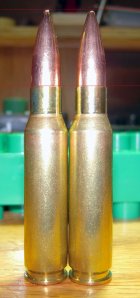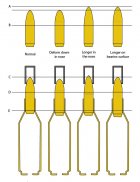To avoid hijacking another thread, this is a continuation of the conversation I have been having in that thread – this one:
http://forum.accurateshooter.com/index.php?topic=3790387.0
In that thread in Reply#28, I measured five hundred 175gr SMKs and found that their bearing surface length (BSL)/base-to-ogive length (BTOL) numbers were similar but varied by a maximum of 0.020â€. I hypothesized that this difference in BSL/BTOL might affect the seating depths of the bullets and thus case volume available for power, and possibly chamber pressure/accuracy. So I set out to prove that this difference in BSL/BTOL can in fact translate to a significant difference in seating depth.
Since it is very difficult to determine exactly where the Hornady comparator tool touch the ogive of the bullet vs. where the bullet seater touch the ogive, I came up with the idea that perhaps the best way is to go directly to measure how deep the two bullets with 0.02†difference in BSL/BTOL would seat in a case.
So here is what I did:
1. Chose two bullets from the two extreme in BSL/BTOL.
2. Measured bullet weight, BSL, BTOL, and actual bullet length (base to meplat).
3. Chose two Win 308 cases and measured case weight, and length.
4. Seat the two bullets in the two cases normally and measured OAL (ogive) and OAL (base to meplat) of the completed rounds (minus powder and primer).
5. All measurements were done three times with a Mitutoyo Absolute caliper.
The results can be seen in the attached screen dump from my Excel spreadsheet. So a number of observations.
1. There were slight differences in the weight of the two bullets – 0.0733 gr.
2. BSL/BTOL as expected were significant in the 0.0190 to 0.0202†range.
3. Actual bullet length (base to meplat) difference was less – 0.0028â€.
4. Difference in the weight of two cases used was slight (as expected since there are weight sorted cases) - 0.44 gr.
5. Case length was very slight (as expected since these are trimmed cases) – 0.0012â€.
The bullets were seated with a Forster Ultra Micrometer Seater die and both OAL (ogive) was very similar 2.2183†vs 2.2185â€. This is not a surprise as the seater normally can seat reproducibly within 0.001â€
What is interesting is the OAL (base to meplat) was significantly different with the round containing the bullet with the longer BSL/BTOL being about 0.0173†shorter. Keeping in mind that the shorter bullet’s overall bullet length (base to meplat) was 0.0028†shorter, I added this number to the OAL (base to meplat) of the shorter round to normalize its length which brought its length from 1.7993†to 1.8022â€. With this new number, the actual length difference between the two rounds is 0.0202†which is exactly the difference in the BSL/BTOL length of the bullet.
So this appears to confirm that in fact a bullet with a longer BSL/BTOL will seat deeper into the case and reduce case volume.
To further confirm the results., here are two photos. The first is of the two bullet/case combo. I put three lines in there showing that the two cases were identical except for the location of the end of their meplat. The right combo has the bullet with the longer BSL/BTOL and the bullet is seated in further.
To make the point even clearer, I took a surgical scalpel and scored the bullet where they were exposed at the neck of the case. The bullets where then pulled with a Hornady Cam-Lock bullet puller and places side by side and this can be seen in the third photo. You can see how much higher the score mark is in the bullet with the longer BSL/BTOL again showing that the bullet was seated deeper into the case.
Using the Photoshop measuring tool and the known fact that the bullet diameter is 0.308â€, the difference in the score marks is around 0.02â€.
So it would appear that all the numbers confirm that a bullet with 0.02†longer BSL/BTOL will seat 0.02†deeper in the case.
Since the normal SOP for tuning groups after an OCW is to seat bullets deeper by 0.01†increment, it is clear that it is worth sorting bullets by BSL/BTOL if they vary anywhere close to this magnitude.
http://forum.accurateshooter.com/index.php?topic=3790387.0
In that thread in Reply#28, I measured five hundred 175gr SMKs and found that their bearing surface length (BSL)/base-to-ogive length (BTOL) numbers were similar but varied by a maximum of 0.020â€. I hypothesized that this difference in BSL/BTOL might affect the seating depths of the bullets and thus case volume available for power, and possibly chamber pressure/accuracy. So I set out to prove that this difference in BSL/BTOL can in fact translate to a significant difference in seating depth.
Since it is very difficult to determine exactly where the Hornady comparator tool touch the ogive of the bullet vs. where the bullet seater touch the ogive, I came up with the idea that perhaps the best way is to go directly to measure how deep the two bullets with 0.02†difference in BSL/BTOL would seat in a case.
So here is what I did:
1. Chose two bullets from the two extreme in BSL/BTOL.
2. Measured bullet weight, BSL, BTOL, and actual bullet length (base to meplat).
3. Chose two Win 308 cases and measured case weight, and length.
4. Seat the two bullets in the two cases normally and measured OAL (ogive) and OAL (base to meplat) of the completed rounds (minus powder and primer).
5. All measurements were done three times with a Mitutoyo Absolute caliper.
The results can be seen in the attached screen dump from my Excel spreadsheet. So a number of observations.
1. There were slight differences in the weight of the two bullets – 0.0733 gr.
2. BSL/BTOL as expected were significant in the 0.0190 to 0.0202†range.
3. Actual bullet length (base to meplat) difference was less – 0.0028â€.
4. Difference in the weight of two cases used was slight (as expected since there are weight sorted cases) - 0.44 gr.
5. Case length was very slight (as expected since these are trimmed cases) – 0.0012â€.
The bullets were seated with a Forster Ultra Micrometer Seater die and both OAL (ogive) was very similar 2.2183†vs 2.2185â€. This is not a surprise as the seater normally can seat reproducibly within 0.001â€
What is interesting is the OAL (base to meplat) was significantly different with the round containing the bullet with the longer BSL/BTOL being about 0.0173†shorter. Keeping in mind that the shorter bullet’s overall bullet length (base to meplat) was 0.0028†shorter, I added this number to the OAL (base to meplat) of the shorter round to normalize its length which brought its length from 1.7993†to 1.8022â€. With this new number, the actual length difference between the two rounds is 0.0202†which is exactly the difference in the BSL/BTOL length of the bullet.
So this appears to confirm that in fact a bullet with a longer BSL/BTOL will seat deeper into the case and reduce case volume.
To further confirm the results., here are two photos. The first is of the two bullet/case combo. I put three lines in there showing that the two cases were identical except for the location of the end of their meplat. The right combo has the bullet with the longer BSL/BTOL and the bullet is seated in further.
To make the point even clearer, I took a surgical scalpel and scored the bullet where they were exposed at the neck of the case. The bullets where then pulled with a Hornady Cam-Lock bullet puller and places side by side and this can be seen in the third photo. You can see how much higher the score mark is in the bullet with the longer BSL/BTOL again showing that the bullet was seated deeper into the case.
Using the Photoshop measuring tool and the known fact that the bullet diameter is 0.308â€, the difference in the score marks is around 0.02â€.
So it would appear that all the numbers confirm that a bullet with 0.02†longer BSL/BTOL will seat 0.02†deeper in the case.
Since the normal SOP for tuning groups after an OCW is to seat bullets deeper by 0.01†increment, it is clear that it is worth sorting bullets by BSL/BTOL if they vary anywhere close to this magnitude.














